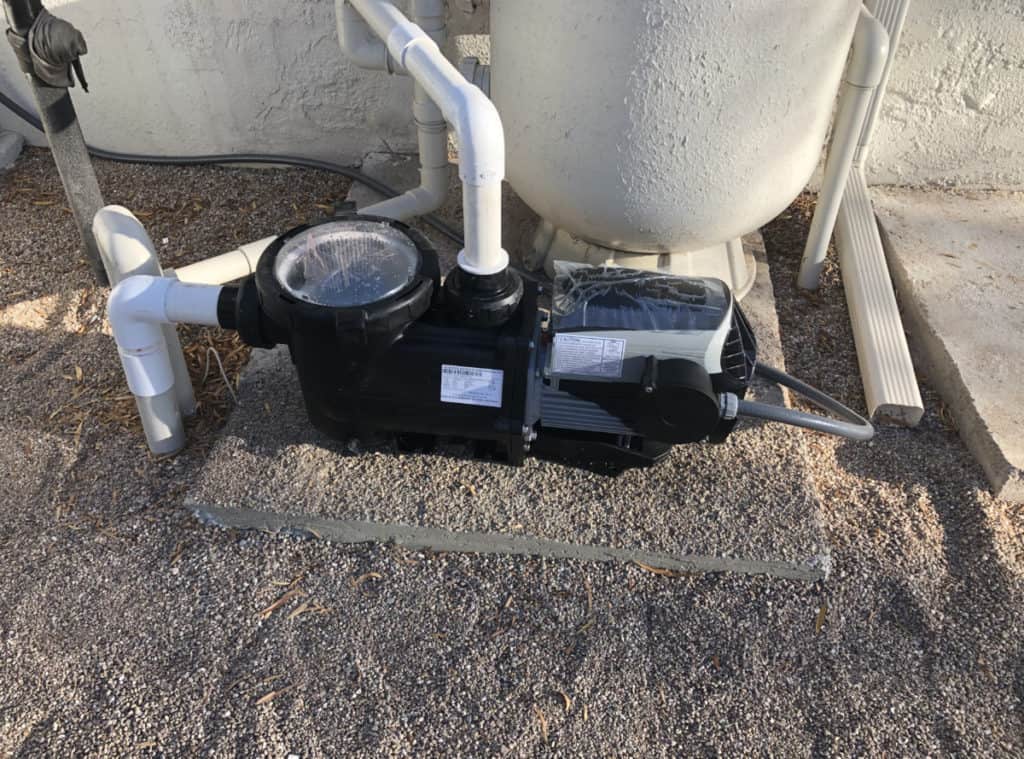Pool pump voltage is important information for the homeowner. Too little or too much voltage can cause serious damage to your pump. Wiring properly for your pump can make all the difference in how long your pump functions efficiently.
Pool pumps are wired to run on 110V or 220V. Dual speed pump motors can work on either voltage while single speed pumps are more likely to be wired specifically for 110V or 220V. In general, the smallest pumps will be wired for 110V, while the largest pumps are wired for 220V. Most of the mid-range pumps are compatible with both.
How can you tell which voltage your pump is? What happens if you connect it to the wrong voltage? Read on to find the answer to these questions and more.

Do Pool Pumps Run On 110 or 220?
Pool pumps are something of an enigma when it comes to wiring. The smallest pumps run on 110V. The largest pumps run on 220V.
In the middle is a huge range of pumps that can run on either 110V or 220V, depending on how you connect them.
As well, sometimes two pumps will have the exact same horsepower rating, but one will be wired for 110V and the other for 220V.
This can be confusing to the consumer who has a limited understanding of circuitry.
Generally, any pump that pulls more than 115 amperes will require 220V wiring. This includes some dual-speed and nearly all variable-speed pumps.
Pumps with an output of 1HP or less will usually be wired for 110V. These are usually single-speed pumps.
Determining your Pump’s Voltage Requires Sleuthing
It can be a hassle to determine whether your pump is a 110V or 220V, but it is possible. There are several ways you can check for information to identify your pump’s voltage.

Wiring Tells The Tale
You can sometimes tell the difference by looking at the wires. Pumps wired for 220V will have three wires:
- Red
- Black
- Green
The red and black are both hot; 220V wiring has no neutral. The green wire is the ground wire.
Pumps wired for 110V will also have three wires, but these will be:
- Black
- White
- Green
The black is hot, the white is neutral, and the green is the ground wire. Identifying these colors can help you determine your pump’s voltage requirements.
Labels Give Away Information
Almost all pumps will have a label on them that identifies horsepower, etc. Sometimes, the pumps voltage will be listed on this label.
This is helpful in quickly identifying which wiring your pump has. Doxycycline online order If your label is too faded to read or has come off, you can look for a model or serial numbers engraved on the pump.
These numbers can help you look up your pump’s information online.
The Owner’s Manual Has The Info
If you still have the owner’s manual that came with your pump, you can take a quick look to establish your pump’s voltage.
There should be a wiring diagram somewhere in the book that will give you some information about the pump’s wiring.
Meters Remove All Doubt
If all else fails in revealing your pump’s voltage, you can always test it using a voltmeter. You must be very cautious doing this to avoid risk of electric shock.
Unplug the motor or throw the breaker before attempting to open the wiring panel. Remember, 220 volts don’t play!
Voltage Makes A Difference
You may be wondering why it is so important to know what voltage your pump is wired for. This is vital information for a couple of reasons.
- Mismatched wiring will ruin your pool pump
- Replacement pumps must match exactly to the old pump
If you don’t know your pump’s voltage, you could create an unintended disaster that would cost you hundreds, if not thousands of dollars.
For example, if your pump is wired for 110V, but you run it on 220V, your pump will burn out in a matter of minutes. At twice the voltage it was designed for, it will overheat and destroy itself.
If it is designed for 220V, but you run it on 110V, it will perform poorly, if at all. And over an only slightly longer period, it will stop working. It has only half the power it needs to do its job.
If your pool is wired for 220V, but you replace your old pump with a 110V pump (or vice versa), you have the same problems.
To keep your pump running as long as possible, you need to know your pump’s voltage and be sure that the pool wiring is appropriately matched for that voltage.
When In Doubt, Which Voltage Should You Choose?
If you know your pump’s voltage is 110V, you know the wire gauge and number of breakers you need.
If your pump is 220V, you know you need two breakers and heavier wiring. But if your pump is compatible with both, how do you choose which to use?
The answer is the best voltage is the one that’s right for your pool.
Both voltages use exactly the same kilowatt hours, so you aren’t saving money with a 110V pump over a 220V pump.
The 110V will pull more current because it has to run longer to get the job done. But the wattage remains the same.
When your pump is compatible with either 110V or 220V, choose the one that will enable your pump to do its job most effectively.
In terms of safety, 110V is considered safest because the risk of electric shock is lower. However, 220V is considered by some to be more efficient because it can accomplish in thirty minutes what takes 110V one hour.
There is no hard and fast rule about this, but it is generally recommended to go with the highest voltage that your pump will tolerate so that your pump doesn’t need to work quite so hard.
Remember Safety First With Electricity
Your pool wiring is as essential as your pump wiring. If you aren’t sure about your pool wiring, you may want to have a certified electrician look at it to determine if it is adequate for your needs.
Never try to replace wiring yourself if you do not know precisely what you are doing. At 110V, you may get an unpleasant jolt, but at 220V, you may be dead before you know what happened.
If you do connect your pool pump to the power supply, be sure you throw all breakers to the area where you will be working before attempting to connect the pump.
Never try to maintenance the pump with the electricity active. Disconnect or interrupt the power supply before servicing your pump in any way.
Water and electricity do not mix!
HP And Amperes Decide Voltage
To summarize, a pool pump’s voltage requirements are based on amperage and HP rating. The larger the HP, the more amperage it will pull.
While many pumps are compatible with either 110V or 220V, they may function more efficiently at higher voltage.
Some pumps that are wired for one voltage can be converted to the other voltage, but some brands like the Hayward pump cannot be converted.
They must be connected to the voltage specified by the manufacturer.
Always be sure that you read and understand the owner’s manual before attempting to do it yourself.
If you are not very familiar with electricity, it’s better to have a professional install your pump. It’s always better to be safe than sorry.
